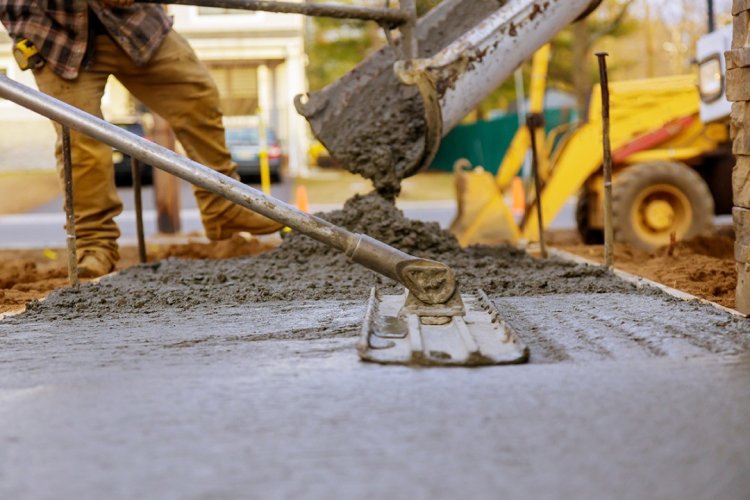How Weather Affects Concrete Curing And Durability?
Learn how weather conditions like heat, cold, and humidity affect concrete curing, durability, and overall strength.

Weather conditions directly impact the strength and durability of concrete structures through their effect on the curing process. During curing, concrete develops its structural properties through specific chemical reactions that depend heavily on environmental conditions. Temperature, humidity, rainfall, and wind each play distinct roles in determining the final quality of concrete work.
Temperature variations can accelerate or slow the curing process, while humidity levels affect concrete's structural development. Rainfall impacts both surface quality and internal structure, and wind conditions create unique challenges during the curing phase. These environmental factors work together, creating situations that require precise management and timing in construction projects.
Importance of Proper Curing
Proper concrete curing defines construction quality. When you order Concrete in London Near You, understanding this process helps ensure project success. The curing period is when concrete develops its core strength through hydration - the chemical reaction between cement and water.
Key Benefits
Effective curing provides three main advantages:
-
Enhanced Strength Development: The continuous hydration process ensures optimal strength gain through controlled conditions.
-
Improved Durability: Well-cured concrete shows reduced permeability, increasing resistance to water and chemical penetration.
-
Superior Surface Quality: Proper curing prevents surface cracking and dusting, resulting in better wear resistance.
Timing and Protection Methods
The first week is critical for strength development, requiring consistent moisture and temperature conditions. Construction teams use several protection methods:
-
Water Curing - Using sprinklers to maintain moisture
-
Curing Compounds - Applying protective liquid membranes
-
Sheet Materials - Covering with plastic sheets or wet burlap
The choice depends on project requirements, weather conditions, and site-specific considerations.
Temperature Effects on Concrete Curing
High Temperature Challenges
When temperatures exceed 90°F (32°C), concrete faces significant challenges. High temperatures accelerate setting time, often causing the concrete to set before proper finishing can occur. This rapid setting also increases water evaporation, leading to potential surface cracking and reduced strength.
Key high-temperature solutions include:
-
Early Morning Pours: Schedule concrete work during cooler hours to avoid peak temperatures.
-
Mix Adjustments: Use chilled water or ice in the mix to control concrete temperature.
Cold Weather Impact
Low temperatures present opposite challenges, particularly when they drop below freezing. Cold weather significantly slows the curing process and can lead to strength development issues.
Essential cold weather practices:
-
Temperature Control: Heat mixing water and protect fresh concrete from freezing.
-
Insulation Methods: Use insulating blankets or heated enclosures to maintain adequate curing temperatures.
Best Practices
Temperature management requires constant attention during the curing process. Before you order Concrete in London Near You, check weather forecasts and prepare appropriate temperature control measures. This preparation ensures proper strength development regardless of weather conditions.
Humidity's Role in Concrete Curing
High Humidity Conditions
High humidity affects concrete curing in several ways. While it reduces water evaporation, excessive moisture in the air can lead to longer setting times. This extended setting period requires careful monitoring of the concrete's surface condition.
Main high-humidity effects:
-
Slower Surface Drying: Extended setting times affect finishing schedules and construction timelines.
-
Surface Quality Issues: High moisture levels can cause efflorescence - white deposits on concrete surfaces.
Low Humidity Impact
Low humidity poses significant challenges for concrete curing. Rapid moisture loss in dry conditions can compromise concrete strength and durability.
Key low-humidity solutions:
-
Surface Protection: Apply evaporation reducers to prevent premature moisture loss.
-
Moisture Retention: Use wet burlap or plastic sheeting to maintain necessary moisture levels.
Humidity Management
Successful concrete curing requires balanced moisture conditions. Regular monitoring and quick response to changing humidity levels ensure optimal curing results. Construction teams must adjust their protection methods based on current humidity conditions.
Precipitation and Weather Protection
Heavy Rainfall Impact
Heavy rain presents immediate risks to freshly poured concrete. Direct rainfall can wash away cement particles from the surface, compromising structural integrity. Construction teams must plan carefully when rain threatens their schedule.
Essential rain protection methods:
-
Protective Covers: Use waterproof covers to shield fresh concrete from direct rainfall.
-
Timing Considerations: Monitor weather forecasts and schedule pours during dry periods.
Light Rain Management
Light rain requires different handling approaches. While less damaging than heavy rainfall, even minimal precipitation needs proper management to ensure quality results.
Key light rain strategies:
-
Surface Monitoring: Check surface conditions regularly during light precipitation.
-
Protection Methods: Keep protective materials ready for unexpected weather changes.
Weather Protection Systems
Effective weather protection combines several approaches:
-
Temporary Structures: Use portable shelters or tents for ongoing projects.
-
Emergency Response: Maintain quick-deploy covers for sudden weather changes.
Wind’s Impact on Concrete Curing
High Wind Conditions
Wind significantly affects concrete curing through increased evaporation rates. Strong winds can dry out concrete surfaces too quickly, leading to strength issues and surface cracking. The combination of wind with high temperatures poses particular challenges for construction teams.
Wind Speed Management
Different wind speeds require varying protection levels. Before you order Concrete in London Near You, consider site exposure and typical wind patterns. Proper planning prevents wind-related curing problems.
Optimal Conditions
While calm conditions are ideal for concrete work, construction teams must prepare for various wind scenarios:
-
Monitoring Systems: Track wind speeds and direction throughout curing.
-
Adjustable Protection: Use flexible barrier systems that adapt to changing wind patterns.
Ensuring Successful Concrete Curing
Weather management in concrete curing requires careful attention to multiple factors. Temperature, humidity, precipitation, and wind each demand specific responses and protection methods.
Success in concrete work comes from proactive weather monitoring and swift response to changing conditions. Experienced teams account for all these weather factors in their planning and execution. This comprehensive approach to weather management ensures durable, high-quality concrete structures that perform well over time.
What's Your Reaction?



















